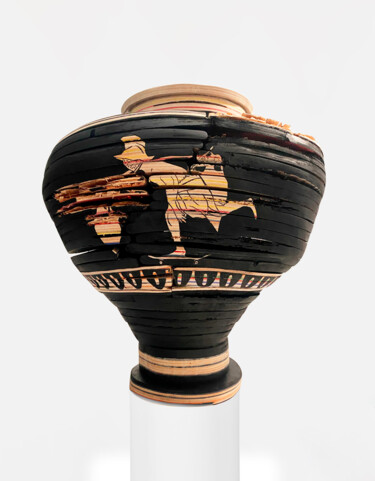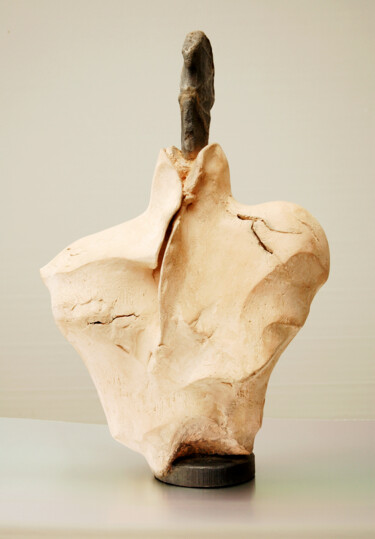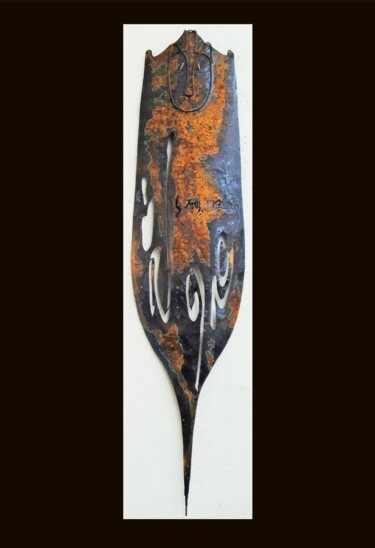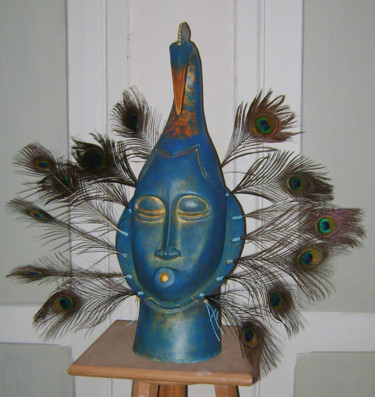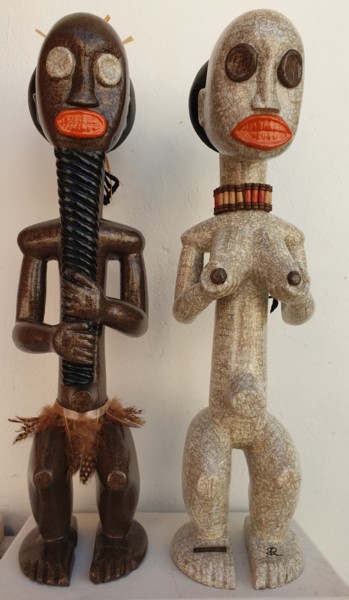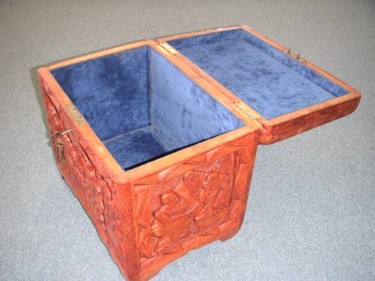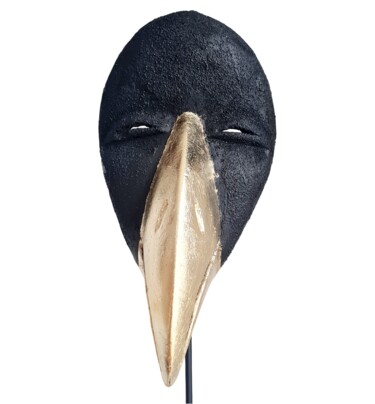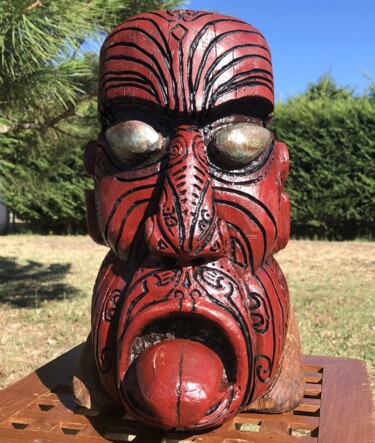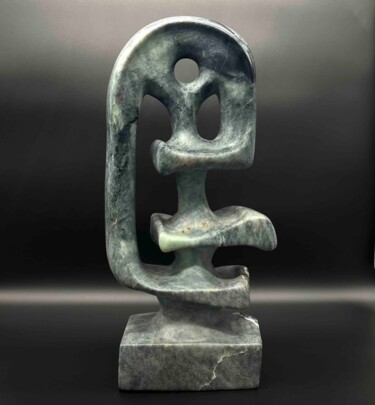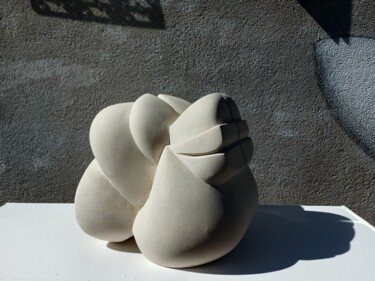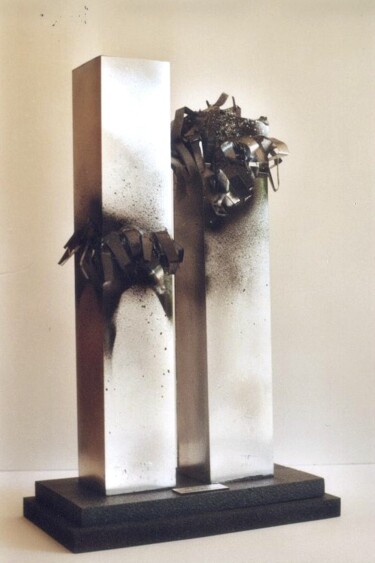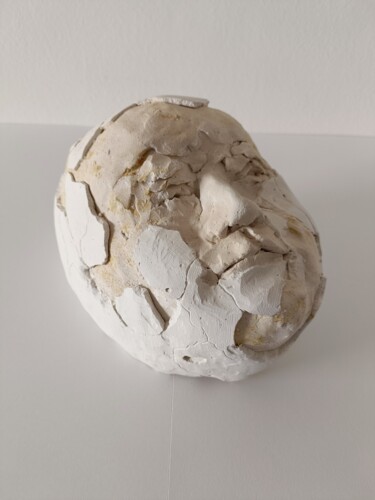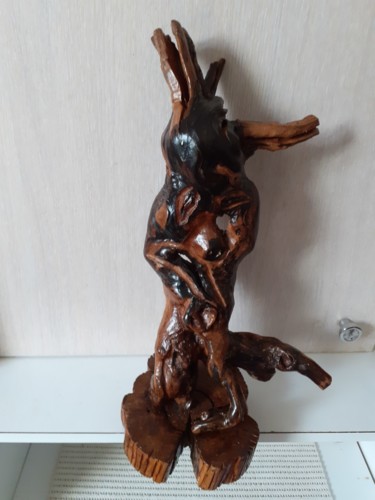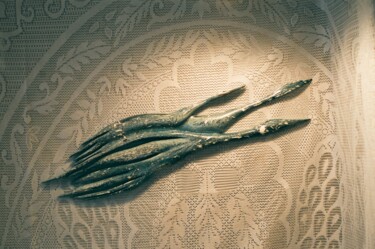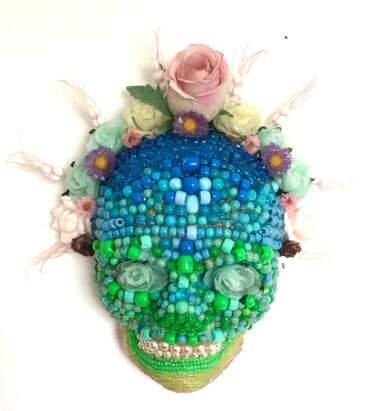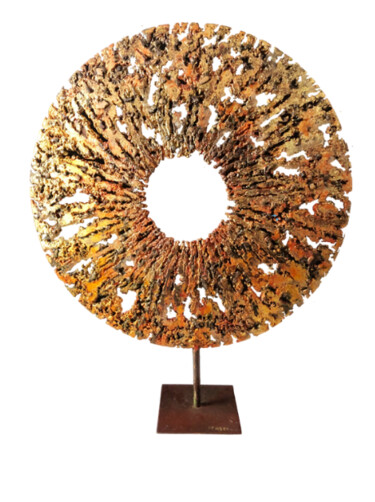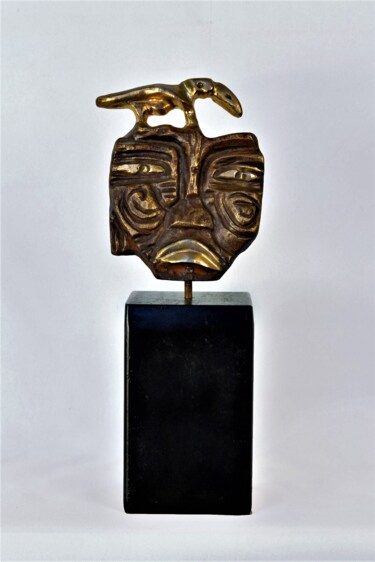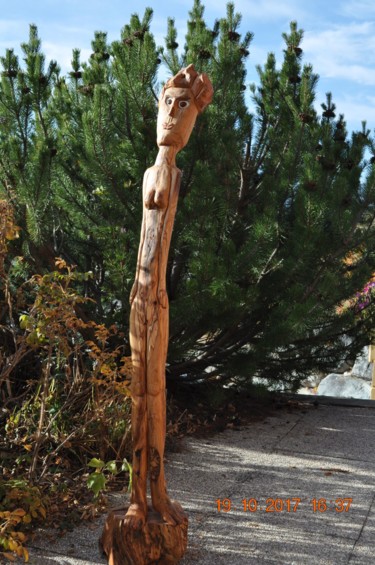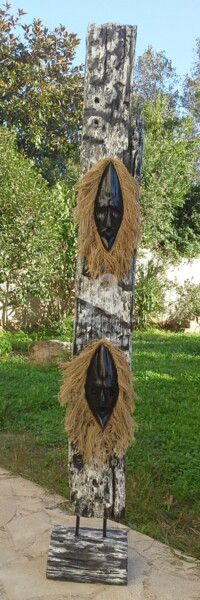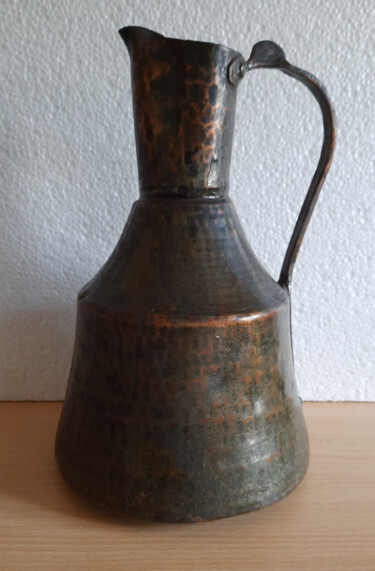36 Esculturas contemporâneas originais à venda:
Como definir estilo Arte tribal ?
As artes visuais e a cultura material dos povos indígenas são referidas como arte tribal, às vezes conhecida como arte não-ocidental, arte etnográfica ou, mais controversamente, arte primitiva. A arte tribal normalmente tem uma função ritualística ou espiritual. O design e artesanato de objetos de culturas tribais, geralmente com origens rurais, são referidos como arte tribal.
No século 19, famosos profissionais da arte ocidental nem mesmo consideravam a arte não-ocidental como arte. Em vez disso, esses objetos eram vistos como relíquias e exemplos de sociedades "exóticas" ou "primitivas". Mas na segunda metade do século 20, as atitudes sobre as artes tribais mudaram. Antes do pós-modernismo surgir na década de 1960, os críticos de arte viam as artes tribais principalmente de um ponto de vista formalista, dando pouca consideração ao significado simbólico, ao contexto histórico ou cultural ou à intenção do artista da peça. Desde então, a arte tribal, como a arte africana nas coleções ocidentais, passou a ser muito valorizada por colecionadores internacionais, exposições e mercado de arte.
A frase "tribal" pode conotar um tipo de arte menos sofisticado que está associado ao primitivismo e sugere falta de habilidade, design, intenção ou conceito. No entanto, à medida que os museus reexaminam e atualizam seus acervos, reconhecendo a realidade de que a arte tribal está longe de ser simples e primitiva e frequentemente tem uma habilidade de execução muito além do que esperamos, ela está ganhando cada vez mais interesse do público. Além disso, tem o poder de alcançar nossas almas. Nossos instintos internos podem ser despertados e nos conectamos com sua verdade como resultado de sua presença convincente e energia emocional, aumentando nossa percepção de profundidade espiritual.
Historicamente, antropólogos ocidentais, colecionadores particulares e museus de etnografia e história natural coletaram obras de arte tribais. Nas coleções de museus, a arte tribal pode ser dividida em três categorias principais: Arte das Américas e da Oceania, especialmente da Austrália, Melanésia, Nova Zelândia e Polinésia; e arte africana, notadamente a da África Subsaariana.
Arte tribal africana
Esculturas em pedra, esculturas em madeira (máscaras e esculturas), joias, cestaria, tecidos, cachimbos, instrumentos musicais, armamento, contas e o design de características arquitetônicas como portas e ornamentação de parede são exemplos de arte tribal africana. O desenvolvimento desses ofícios foi impactado pela acessibilidade de ferramentas, recursos e know-how; nem todas as tribos se engajaram nesses empreendimentos artísticos. O material mais típico era a madeira, freqüentemente decorada com argila, tinta, conchas, miçangas, marfim, metal, penas, pelos de animais, ráfia e, em raras ocasiões, até pedras semipreciosas.
A arte africana era uma parte fundamental de uma religião abrangente. As forças vitais supostamente presentes em todos os seres vivos eram representadas por imagens específicas que agiam como suas personificações ou representantes. A essência da ancestralidade da tribo foi preservada por essas representações dos mortos, que frequentemente falavam por eles e davam às pessoas a chance de se conectar com os espíritos ancestrais. Artefatos tribais africanos foram tipicamente criados como arte religiosa - para um ritual específico ou uso cerimonial - apesar do fato de que muitas das formas usadas incluem componentes seculares e algumas obras de arte são puramente decorativas e ornamentais.
A iniciação em grupos de idade, como as "sociedades" de homens jovens ou velhos, cada uma com seus próprios símbolos e motivos de culto, é a base de muitos rituais tribais. Essas "sociedades" são conhecidas por sua abundância de estatuetas e máscaras esculpidas, muitas das quais representam divindades padroeiras como o Deus do Trovão ou o Deus do Fogo. Embora as esculturas fossem quase exclusivamente fabricadas como um item de luxo por algumas sociedades, elas eram tão onipresentes e populares quanto as máscaras e tinham um significado ritualístico. A tribo Yoruba na Nigéria era habilidosa escultora de figuras redondas e frequentemente coroava suas máscaras tipicamente grandes com hordas de bonecos muito vivos, criando a ilusão de que uma festa estava acontecendo. Os escultores podiam alcançar uma estatura e notoriedade um tanto parecidas com as de um artista conhecido no Ocidente por causa do excelente calibre e reputação da escultura africana entre outras tribos, principalmente os iorubás.
Arte Tribal Oceânica
A sub-região da Oceania é composta por quatro regiões etnogeográficas distintas: Polinésia, Micronésia, Melanésia e Australásia. A arte tribal da Oceania refere-se às tradições culturais e à história criativa dos povos indígenas que vivem nessas quatro áreas. Essa cultura Lapita eventualmente teve um impacto na maior parte da Polinésia, Micronésia e Melanésia. Outro fator foi a civilização vietnamita Dong-Son, que floresceu por volta de 600 DC e foi um importante comerciante no Pacífico ocidental. Artefatos de bronze desta civilização foram encontrados em toda a Oceania.
Embora cada região e grupo de ilhas tivesse suas tradições estéticas únicas que moldavam suas artes e ofícios, a arte tribal oceânica estava ligada a eventos pagãos envolvendo o sobrenatural, a adoração de espíritos e a fertilidade. Uma grande variedade de formas de arte, incluindo pintura corporal, tatuagem, pintura, escultura, escultura em madeira e arte têxtil, foi produzida, sendo a maioria dos materiais utilizados por artistas e artesãos perecíveis. Como resultado, apenas um pequeno número de exemplos - excluindo edifícios de pedra e esculturas - persistiu.
As monumentais esculturas de pedra (moai) em Rapa Nui/Ilha de Páscoa e nas Marquesas, exemplificando o uso de desenhos que incorporam figuras antropomórficas com línguas protuberantes e olhos esbugalhados, comuns em muitas áreas orientais e remotas da Polinésia, estão entre os exemplos famosos da arte polinésia. que sobreviveram. Outros exemplos incluem tecidos de casca de árvore altamente ornamentados no oeste da Polinésia.
Por serem usadas em complicados ritos pagãos e práticas de culto em toda a Melanésia, as máscaras eram um motivo-chave na arte indígena. As relíquias tribais da Micronésia também incluem tigelas de madeira esculpidas, barcos pintados e máscaras de madeira estilizadas, além de pintura corporal e tatuagem. Pintura corporal, pintura rupestre, pintura em casca de árvore, gravuras rupestres, menires, entalhes, esculturas e adornos ornamentais em ferramentas e armas são apenas alguns exemplos dos numerosos estilos e mídias usados na arte aborígine australiana.
Arte tribal americana
A arte dos índios americanos foi profundamente impactada tanto pelo estilo de vida nômade e caçador do primeiro quanto pelo ambiente um pouco mais estático, mas ainda assim empobrecido, do segundo. Outro aspecto significativo no surgimento de tradições criativas regionalmente distintas foi a acessibilidade de recursos, incluindo madeira, vime, metal, osso animal, argila e algodão.
As tribos do sudoeste eram especialistas em tecer, fazer cerâmica e criar afrescos. Essas tribos incluíam os povos Zuni, Navaho e Hopi, bem como os Hohokam do sul do Arizona, os Ansazi do norte do Arizona e do Novo México, os Mimbres do sudoeste do Novo México e os Ansazi. Os nativos americanos do sudoeste inventaram a pintura de areia, muitas vezes conhecida como pintura seca (notavelmente o Navajo).
No Centro-Oeste, as tribos eram as únicas responsáveis por moldar a cultura. Essas tribos eram reconhecidas por sua intrincada arte têxtil, bem como por seus conhecidos trabalhos de terraplenagem, ou "montículos de efígies", que foram construídos para se assemelhar a diferentes animais. A arte tribal também compreendia cachimbos de pedra esculpidos com padrões que iam do extremamente realista ao abstrato, além de tigelas de madeira esculpida e pedra polida e ornamentos de cobre.
A região sudeste também produzia cachimbos em forma de pássaros e animais, conchas finamente esculpidas e acessórios de roupas pintadas de maneira elaborada. Apesar de usar argila inferior, era conhecida por produzir cerâmica requintada. Peças de cerâmica foram criadas e adornadas em uma variedade de padrões florais e geométricos para usos cerimoniais, religiosos e privados.
A cestaria nativa americana era um tipo proeminente de arte na Costa Oeste, particularmente na Califórnia. A tribo iroquesa dos índios do nordeste, em particular, era conhecida por seus cintos wampum tecidos, penas de porco-espinho e máscaras da False Face Society. A melhor arte tribal produzida no Noroeste era a escultura, particularmente a escultura em madeira. Totens, pequenas estatuetas de madeira e máscaras meticulosamente pintadas e freqüentemente incrustadas com pedras e conchas de abalone estavam entre os estilos mais populares de escultura esculpida à mão.
Como a arte tribal influenciou a arte moderna
Em meados do século XIX, à medida que mais expedições traziam de volta artefatos tribais, o interesse pelo que era então conhecido como primitivismo/arte primitiva - tipicamente a arte da África negra - começou a crescer. Exposições de arte tribal significativas do final do século 19 e início do século 20 também expuseram a arte não ocidental à comunidade artística ocidental. Exposições importantes, como a American Indian Art de 1941 e a African Negro Art de 1935, foram realizadas no Museu de Arte Moderna.
Os artistas descobriram um modelo para uma alternativa à arte ocidental em estátuas de deuses tribais e máscaras rituais, cujas formas não naturalistas e altamente estilizadas também incorporavam imagens poderosas e altamente emotivas. A arte tribal teve uma influência significativa em artistas famosos como Vincent Van Gogh e Henri Matisse, Paul Gauguin e Pablo Picasso. O efeito inicial mais impressionante foi o cubismo, que, ao fragmentar a imagem e abrir mão da perspectiva, rapidamente enfraqueceu o paradigma ocidental ao basear-se principalmente nas implicações formais da arte tribal. A arte abstrata foi um dos principais resultados disso.
O grupo alemão Die Brücke começou a se concentrar mais nos elementos primitivos, instintivos e ritualísticos da arte não-ocidental por volta do mesmo período, estabelecendo o principal movimento de arte moderna conhecido como Expressionismo. Os dadaístas promoveram a quebra do paradigma ocidental inspirando-se na arte tribal, no cubismo e no expressionismo em Zurique, Nova York e, finalmente, em Paris. O trabalho pictórico ou escultórico de Dada era composto principalmente de colagem e montagem, sua contraparte tridimensional. O fato de que a arte pode ser criada a partir de qualquer coisa e não precisa ser pintada, esculpida ou modelada foi estabelecido por esta obra composta de materiais encontrados. Suas imagens freqüentemente incorporavam aspectos da arte tribal e eram conflituosas em nível político, social ou estético. Dada apresentou os conceitos que eventualmente levaram à arte conceitual, cujo impacto se misturou com os das outras correntes da arte moderna para criar o vasto, amplo, enormemente rico, variado e globalmente diverso rio da arte contemporânea que o mundo desfruta atualmente.
Discover contemporary artworks on Artmajeur
Contemporary art is a vibrant constellation of artistic expressions. This creative universe encompasses a wide array of mediums, from paintings, sculpture, and photography to drawing, printmaking, textile art, and digital art, each medium a star shining with its own distinct radiance. Artists use diverse supports and materials to bring their visions to life, such as canvas, wood, metal, and even innovative digital canvases for the creation of virtual masterpieces.
A contemporary painting, for instance, may weave its story through the masterful strokes of acrylic or oil, while a contemporary sculpture might sing its song in the language of stone, bronze, or found objects. The photographic arts capture and manipulate light to produce striking images, while printmaking employs techniques like lithography and screen-printing to produce multiples of a single, impactful image. Textile art plays with fabrics and fibers, whereas digital art pushes the boundaries of creation with innovative technology.
The allure of contemporary art lies in its boundary-pushing nature, its relentless quest for experimentation and its constant reflection of the evolving human experience. This boundless creativity, coupled with its strong social and personal commentary, makes every piece of contemporary art a unique emblem of its time, a mirror held up to the realities and dreams of our complex world. It whispers to us, moves us, provokes thought, and kindles a deep emotional response, stirring the soul of anyone willing to listen. It is, indeed, the language of emotions and ideas, spoken in the dialect of our era.
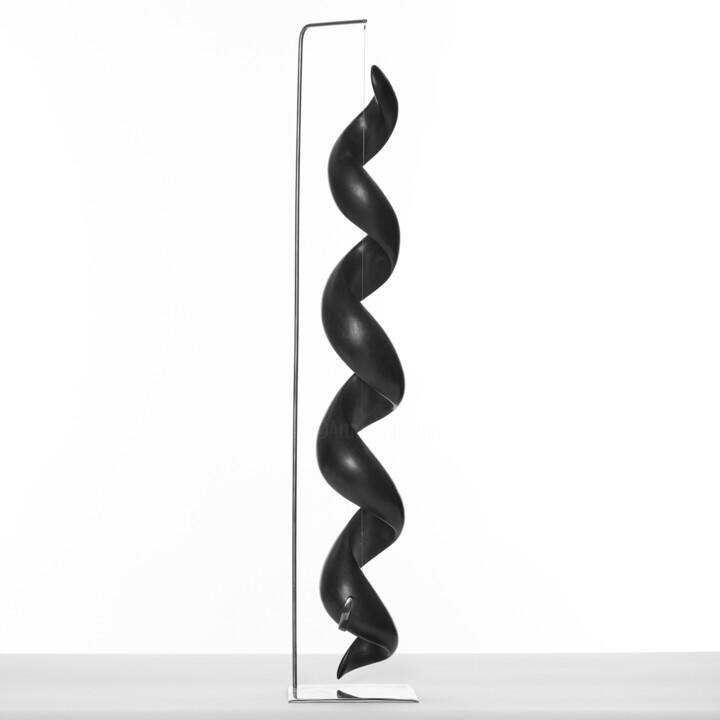
©2017 Thierry Ledé
Origins and history of contemporary art
The story of contemporary art unfolds in the mid-20th century, marked by seismic shifts in artistic expression. Post-World War II, around the 1950s and 1960s, artists began experimenting beyond traditional confines, challenging the norms of what art could be. This revolutionary epoch birthed myriad new movements and artistic forms such as abstract expressionism, pop art, and minimalism. Paintings, once confined by realism, embraced abstraction, as artists used color and form to express emotions and ideas. Notable periods like the advent of pop art in the late 1950s and early 1960s saw artworks mimicking popular culture and mass media, reflecting society’s shifting focus.
The sculptural arts, too, witnessed a metamorphosis. Sculptors started to experiment with new materials and forms, often creating artworks that interacted with the viewer and the surrounding space, fostering a sense of engagement. Drawing, a timeless practice, also evolved, with artists incorporating innovative techniques and concepts to redefine its role in contemporary art.
Photography, a relatively new medium, emerged as a powerful tool in the contemporary art landscape. Born in the 19th century, it truly came into its own in the latter half of the 20th century, blurring the lines between fine art and documentation. Printmaking, a practice dating back to ancient times, saw renewed interest and experimentation with techniques like lithography, etching, and screen printing gaining prominence.
The realm of textile art expanded dramatically, as artists began to appreciate the versatility and tactile quality of fabric and fibers. Artists began using textiles to challenge the boundaries between fine art, craft, and design.
The dawn of digital technology in the late 20th century heralded a new age for contemporary art. Digital art emerged as artists started leveraging new technologies to create immersive, interactive experiences, often blurring the line between the virtual and the physical world.
Through these transformative periods, the essence of contemporary art has remained the same: a dynamic, evolving reflection of the times we live in, continually pushing boundaries and embracing the new, always questioning, always exploring.
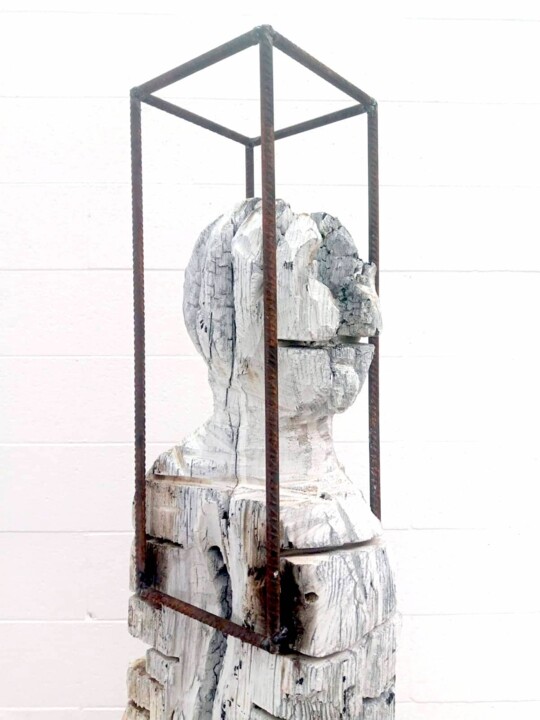
©2023 Joshua Stazio
Evolutions of theses contemporary works in the art market
As we navigate through the 21st century, the dynamic landscape of contemporary art continues to evolve and expand, reflecting our ever-changing world. Contemporary paintings, once primarily confined to two-dimensional canvases, now embrace a multitude of forms and techniques, ranging from mixed media installations to digital creations, each piece a rich a weaving of thoughts, emotions, and narratives. Sculpture, too, has ventured far beyond traditional stone and bronze, with artists incorporating light, sound, and even motion, embodying the ephemerality and flux of the modern world.
Photography, in the hands of contemporary artists, has expanded its horizons, seamlessly blending with digital technology to create breathtaking imagery that challenges our perception of reality. Drawing, as well, has transcended the borders of paper, incorporating multimedia elements and exploratory techniques to redefine its role in the artistic discourse. Printmaking continues to flourish, with contemporary artists using traditional methods in innovative ways to deliver potent social and personal commentaries.
Textile art, once considered a craft, now holds a prominent place in the contemporary art world, with artists using it to explore issues of identity, tradition, and cultural heritage. Meanwhile, digital art, the newest member of the contemporary art family, has revolutionized the way we create and interact with art, presenting immersive experiences that blur the boundary between the virtual and the physical.
These diverse forms of contemporary art hold significant value in the current art market, not only due to their aesthetic appeal but also their ability to encapsulate and communicate complex ideas and emotions. Collectors, curators, and art lovers worldwide seek these works, drawn to their inherent dynamism, their innovative use of materials, and their eloquent expressions of our shared human experience. As a testimonial to our times, these contemporary artworks encapsulate the pulse of our society and the resonance of individual voices, forever etching our collective narrative into the annals of art history.
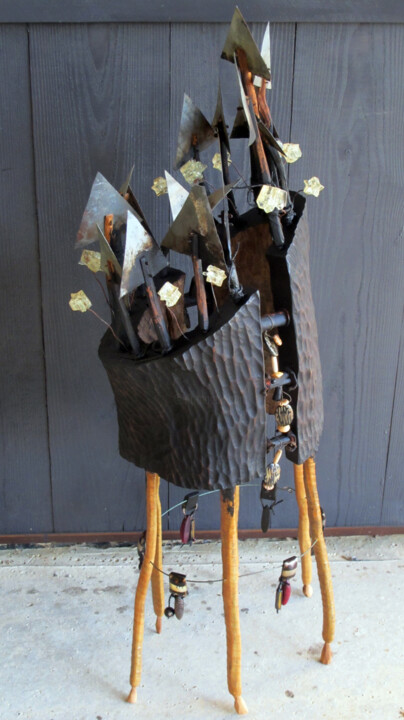
©2023 Alain Platet
Famous Contemporary Artists
As we delve into the vibrant realm of contemporary art, we encounter an array of artists who shape this dynamic field. Each a master in their medium - painting, sculpture, photography, drawing, printmaking, textile, or digital art - they push artistic boundaries, reflecting our era and challenging perceptions. Let’s explore these remarkable contributors and their groundbreaking works.
1. Gerhard Richter - Known for his multi-faceted approach to painting, Richter challenges the boundaries of the medium, masterfully oscillating between abstract and photorealistic styles. His works, whether featuring squeegee-pulled pigments or blurred photographic images, engage in a fascinating dialogue with perception.
2. Jeff Koons - A significant figure in contemporary sculpture, Koons crafts monumental pieces that explore themes of consumerism, taste, and popular culture. His iconic balloon animals, constructed in mirror-polished stainless steel, captivate with their playful yet profound commentary.
3. Cindy Sherman - An acclaimed photographer, Sherman uses her lens to explore identity and societal roles, particularly of women. Renowned for her conceptual self-portraits, she assumes myriad characters, pushing the boundaries of photography as a medium of artistic expression.
4. David Hockney - Hockney, with his prolific output spanning six decades, is a pivotal figure in contemporary drawing. His bold use of color and playful exploration of perspective convey an intoxicating sense of joy and an unabashed celebration of life.
5. Kiki Smith - An innovative printmaker, Smith’s work explores the human condition, particularly the female body and its social and cultural connotations. Her etchings and lithographs speak to universal experiences of life, death, and transformation.
6. El Anatsui - A master of textile art, Anatsui creates stunning tapestry-like installations from discarded bottle caps and aluminum scraps. These shimmering, flexible sculptures blend traditional African aesthetic with contemporary art sensibilities, speaking to themes of consumption, waste, and the interconnectedness of our world.
7. Rafael Lozano-Hemmer - A leading figure in digital art, Lozano-Hemmer utilizes technology to create interactive installations that blend architecture and performance art. His work, often participatory in nature, explores themes of surveillance, privacy, and the relationship between people and their environments.
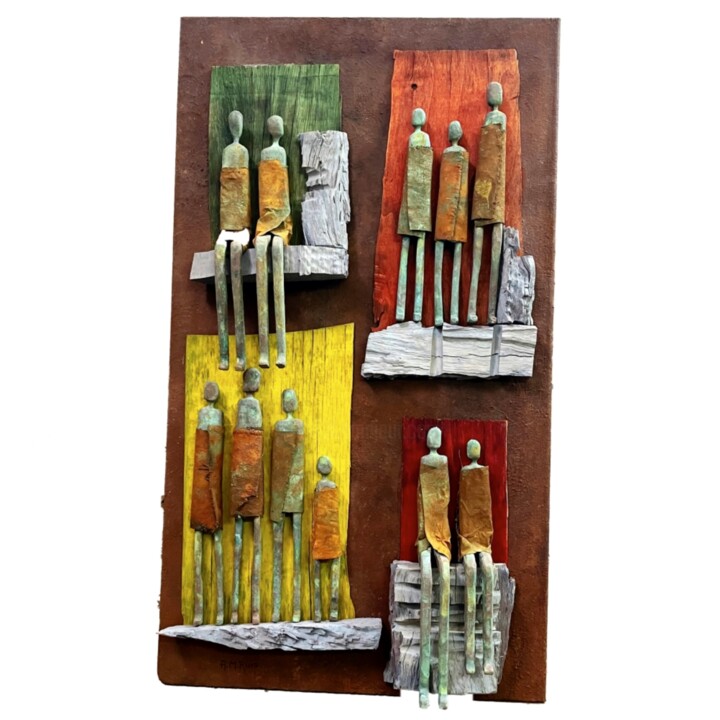
©2023 Antonio Martinez Ruiz
Notable contemporary artworks
The contemporary art landscape is a dynamic patchwork of diverse expressions and groundbreaking ideas, each artwork a unique dialog with its audience. Here are a selection of some renowned contemporary artworks, spanning various media such as painting, sculpture, photography, drawing, printmaking, textile art, and digital art, that have profoundly influenced this vibrant movement.
"Cloud Gate" by Anish Kapoor, 2006 - This monumental stainless steel sculpture, also known as "The Bean," mirrors and distorts the Chicago skyline and onlookers in its seamless, liquid-like surface, creating an interactive experience that blurs the line between the artwork and the viewer.
"Marilyn Diptych" by Andy Warhol, 1962 - An iconic piece of pop art, this silkscreen painting features fifty images of Marilyn Monroe. Half brightly colored, half in black and white, it reflects the dichotomy of celebrity life and its influence on popular culture.
"Rhein II" by Andreas Gursky, 1999 - This photographic artwork, a digitally-altered image of the Rhine River, is celebrated for its minimalist aesthetic. It strips the landscape to its bare essentials, invoking a sense of tranquility and vastness.
"Black Square" by Kazimir Malevich, 1915 - A revolutionary painting in the realm of abstract art, this piece, featuring nothing more than a black square on a white field, challenges traditional notions of representation, symbolizing a new era in artistic expression.
"Puppy" by Jeff Koons, 1992 - This giant sculpture, a West Highland Terrier blanketed in flowering plants, explores themes of innocence, consumer culture, and the interplay between high art and kitsch. It’s a delightful blend of traditional sculpture and garden craft.
"Re-projection: Hoerengracht" by Ed and Nancy Kienholz, 1983-1988 - A room-sized tableau representing Amsterdam’s red-light district, this work combines elements of sculpture, painting, lighting, and found objects. It engages viewers in a stark commentary on commodification and objectification.
"Untitled" (Your body is a battleground) by Barbara Kruger, 1989 - This photomontage, combining black-and-white photography with impactful text, explores issues of feminism, identity, and power. Its potent, confrontational message is a prime example of the power of text in contemporary visual art.
"For the Love of God" by Damien Hirst, 2007 - This sculpture, a platinum cast of a human skull encrusted with 8,601 diamonds, probes themes of mortality, value, and the human fascination with luxury and decadence. It’s a compelling blend of macabre and magnificence.
"Physical impossibility of Death in the Mind of Someone Living" by Damien Hirst, 1991 - This artwork, featuring a tiger shark preserved in formaldehyde, blurs the line between traditional sculpture and biological specimen. It prompts viewers to contemplate mortality and nature’s ferocity.
"One and Three Chairs" by Joseph Kosuth, 1965 - A piece of conceptual art, it presents a physical chair, a photograph of a chair, and a dictionary definition of a chair, thus exploring the relationship between language, picture, and referent in art.
These pieces, in their diversity, exemplify the rich tapestry of contemporary art, each piece a unique commentary on our world and a testament to the limitless potential of creative expression.
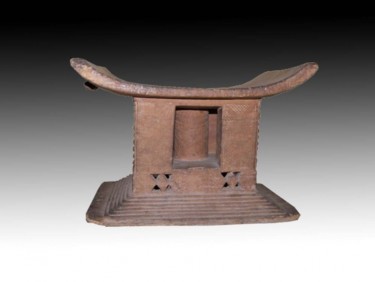
Kebe
Escultura - Madeira | 11,4x11,4 in
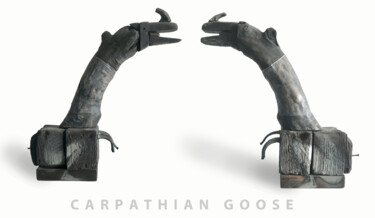
Sergii Shkoliar
Escultura - Madeira | 16,1x4,1 in
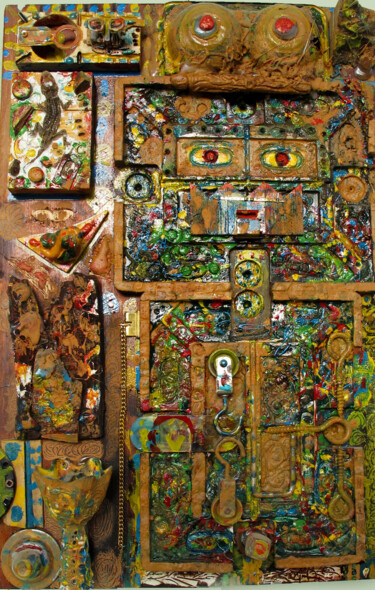
Damiano Ventimiglia
Escultura - Plástico | 23,6x15,8 in
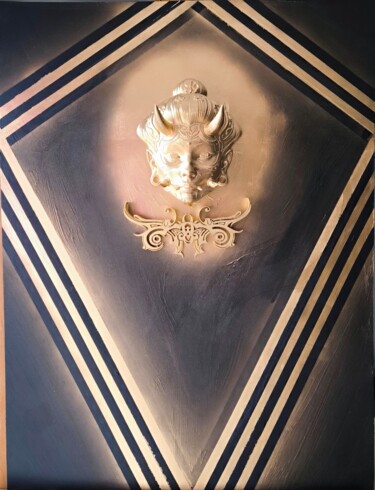
Manuel Molina
Escultura - Plástico | 31,5x23,6 in
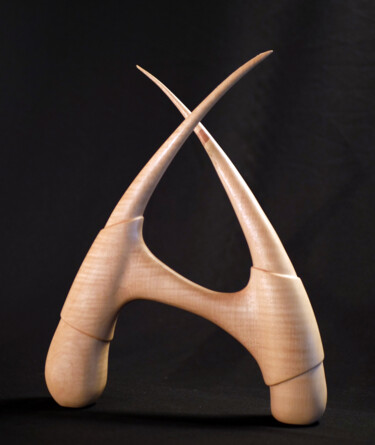
Frank Dreyer
Escultura - Madeira | 12x9,5 in
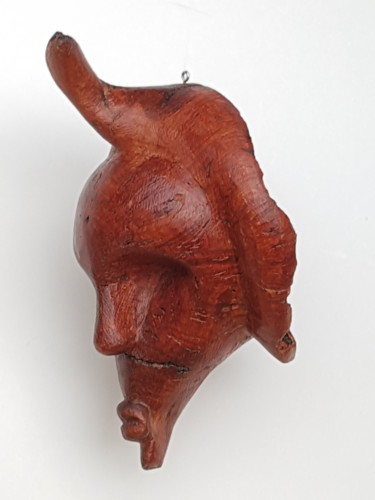
Cécile Devezeaux De Lavergne
Escultura - Madeira | 7,9x5,5 in
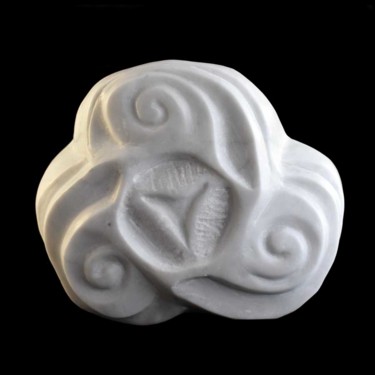
Rommel Cristina
Escultura - Pedra | 7,5x8,7 in




